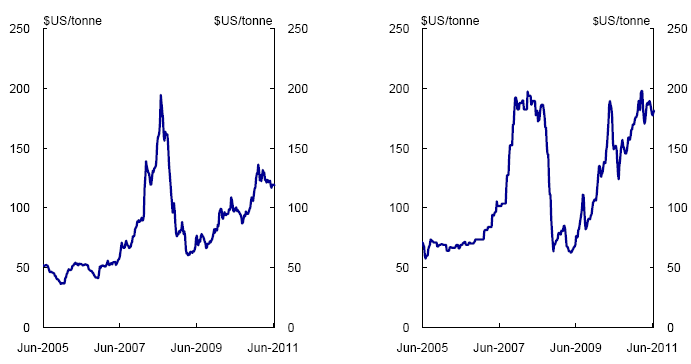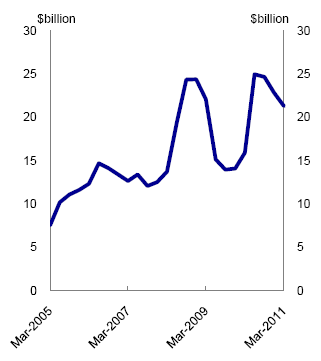Government Senators Dissenting Report
Introduction
Senator Hutchins and Senator Cameron do not agree with the
recommendations in the Coalition Senators' report.
Government Senators find that the Mineral Resource Rent Tax
and the extension of the Petroleum Resource Rent Tax onshore will deliver
significant positive and beneficial returns to Australia, particularly the
regions.
Current mining boom
Australia is going through a mining boom that by almost any
economic indicator is unprecedented.
Commodity prices have increased significantly, especially in
iron ore.
Thermal Coal (Newcastle, FOB) Iron
Ore (CFR)

Source: Global Coal Source:
Bloomberg
These commodity prices have in turn spurred a mining
investment boom. Since the Government announced its mining tax reforms, mining
investment has skyrocketed from $35 billion last year (09-10), to $51 billion
this year (10-11), to an expected $83 billion in 2011-12. Mining employment
has also grown substantially by 19.4 per cent – that’s 35,200 mining jobs -
compared to 2.3 per cent for the whole economy over the same period.
The latest ABARES quarterly commodities report shows that
Australian energy and minerals export earnings are forecast to increase by 33
per cent to around $186 billion in 2010-11, before increasing by a further 16
per cent to $215 billion in 2011-12.
Exploration is also growing. Junior exploration companies
also continue to get lots of interest – in December 2010 they made up 88 per
cent of all resource sector initial public offerings.
The resources of all Australians
It is clear that the current mining boom is delivering
record profits to miners. Mining profits were $25 billion in the September
quarter.
Mining profits

Source: ABS cat no. 5676.0
Much of these profits travel off-shore to foreign owners,
yet a lot of it has little to do with the investment in labour or capital by
mining companies. Mining can be a difficult and specialised industry that
requires high returns to workers and investors. But the kinds of returns mining
interests are sometimes currently accruing can be out of all proportion to
these costs. Instead, much of their profit can be due to the inherent
underlying and finite value of the resources owned by Australians. It is an
inescapable fact that when these minerals are dug up and sent overseas they are
gone forever.
The Government’s tax reforms
The Government’s tax reforms respond to these pressures by
returning a fairer share of nation’s wealth to Australians.
The 2011-12 Budget includes net revenue from the MRRT is
$3.7 billion in 2012-13, $4 billion in 2013-14, and $3.4 billion in 2014-15,
which represents the net impact on revenue across several different revenue
heads. This includes the offsetting reductions in company tax (through
deductibility) and interactions with other taxes.
The MRRT revenue is being used to fund important tax and
superannuation reforms, including
-
a company tax cut for all companies to 29 per cent on
1 July 2013; and
-
a new tax break for up to 2.7 million small businesses, from
1 July 2012
-
investment in our regions, through a Regional Infrastructure Fund
-
simplifying personal tax for 6.4 million Australians with a $500
standard deduction from 1 July 2012 and a $1,000 deduction from 1 July 2013;
-
rewarding personal saving of over 5 million Australians, with a
50% tax discount on up to $500 of interest income from 1 July 2012,
increasing to up to $1,000 of interest income from 1 July 2013;
-
a boost to superannuation for 8.4 million Australians, with the
first increase on 1 July 2013; and
-
expanded superannuation concessions for 3.5 million low income
earners and about 275,000 over 50s from 1 July 2012.
The Government’s mining tax means lower taxes, more
infrastructure and greatly increased personal savings for ordinary Australians.
The Coalition Senators' report recommends the MRRT revenue
be used to repay debt or be devoted to the Future Fund. This would mean
foregoing all of the important investments in more competitive business taxes,
tax relief for small business, simplified personal taxes with bigger tax
returns, new regional infrastructure, and greater savings through
superannuation. These initiatives are important investments in the growth of
Australia’s entire economy, and will see Australia save more of the gains
through the 8.4 million superannuation accounts of Australian workers.
The MRRT
The MRRT will apply to all new and existing iron ore and
coal projects and will apply at a rate of 30 per cent. An extraction allowance
of 25 per cent reduces the effective rate of the MRRT to 22.5 per cent.
Under the MRRT, the government taxes positive cash flows, or
mining profits, and allows miners to carry forward and uplift losses (unused
deductions) for use in later years. The tax applies to profits attributable to
the resource close to the point of extraction and therefore avoids taxing the
value adding of the miner such as processing and transportation of the
resource. As such it is a tax on a limited portion of mining profits, unlike
company income tax, which applies to all income.
Under the MRRT, upstream capital expenditure is immediately
deductible. Unlike income tax, capital assets do not have to be depreciated
over their effective lives. The MRRT will be fully deductible for company
income tax purposes.
Small miners
There are a number of features of the MRRT which benefit
smaller miners.
Small miners often have large start up costs of capital.
As new projects will be able to be immediately write-off
investment and immediately deduct expenses, no MRRT will be payable until the
project has made enough profit to pay off its upfront investment.
To the extent that expenses, including capital expenses,
cannot be deducted immediately due to insufficient profit, those losses will be
carried forward and uplifted at the government long term bond rate plus 7 per
cent.
There is also a special concession for small miners.
Mining companies with an annual MRRT profit of $50 million
or less, are entitled to a low-profit offset that will reduce their MRRT
liability to nil. This offset phases out between $50 million and $100 million
of MRRT profit. -
This concession and the inherent design of the MRRT provide
significant advantages to smaller miners.
Royalties are a poor way of getting a return from the resources we own
It is clear that profits-based mining taxes such as the MRRT
are fairer and encourage production compared to royalties. This is because
royalties are either based on revenue or volume, so they hit mining production
from the first tonne of mineral produced, regardless of how costly the resource
is to produce. Also, as a mine approaches the end of its life, and the grade of
iron ore gets worse, royalties continue to charge the same price.
A royalty system therefore can lead to fewer mines starting
up and existing struggling mines to close too soon.
While a royalty system taxes less profitable mines too much,
it also taxes highly profitable mines too little. A mine struggling with high
costs of extraction, for example due to the particular characteristics of the
mineral deposit, pays the same royalty as a mine with little costs and making
lots of profit.
The MRRT will recognise the investment and operating costs
involved in extracting non-renewable resources. For start up mines, it imposes
a charge once the mine production starts making a profit. And for mines nearing
the end of their life it recognises that margins fall as the grade of iron ore
gets worse.
When mining prices are high, the MRRT delivers more revenue
to Australians from selling the resources they own. When they are low,
royalties discourage investment and jobs in mining.
The Australia’s Future Tax System review found state‑based
royalty systems to be unfair and among the most inefficient taxes in Australia.
It also found that profits based resource taxes are one of the most efficient
taxes that can be levied in Australia. A profits-based system will get a better
return for Australia from its non-renewable wealth, and do it in a better and
more efficient way than state royalties.
Development of the MRRT and PRRT
The MRRT and extension of the PRRT to all offshore and
onshore oil and gas projects have been subject to extensive consultations since
they were announced on 2 July 2010.
The Government set up a Policy Transition Group (PTG), led
by the Minister for Resources and Energy, the Hon Martin Ferguson and Mr Don
Argus. The PTG was established to oversee the development of the detailed technical
design of the MRRT and the transition of existing petroleum projects to the
PRRT regime.
The PTG conducted a comprehensive and extensive program of
face-to-face consultations with a range of stakeholders in Perth, Brisbane,
Sydney, Adelaide and Melbourne. Participants included affected mining
companies, relevant industry associations, major accounting firms and other tax
professionals. The PTG consultations were overwhelmingly constructive, as were
the 88 written submissions that were received.
On 24 March 2011, the Government accepted all
recommendations of the PTG relating to the new arrangements. The PTG
recommendations form the basis of the draft MRRT legislation and the PRRT
extension.
One of these recommendations that the Government accepted is
that a Resource Tax Implementation Group be convened to assist in the drafting
of the MRRT legislation. The RTIG includes tax experts and representatives from
the mining industry and has been assisting with the development of draft
legislation for public consultation.
The Government released the draft MRRT Bill and Explanatory
Memorandum on 10 June 2011 for public consultation. Consultation will
run until 14 July 2011. The draft PRRT amendments will be released in
the near future.
Legislation is expected to be
introduced into the Parliament late in 2011 in order for the new resource tax
arrangements to commence as planned on 1 July 2012.
Costings
Estimates of MRRT revenues have been published and regularly
updated since the policy was announced. The 2011-12 Budget includes revised
estimates on page 5-35 of Budget Paper No. 1.
Treasury’s terms of trade forecasts and projections are
published in the Budget, and were updated in the Economic Statement and the
PEFO.
Treasury has explained that it does not publish forecasts of
the commodity prices underlying the terms of trade forecast.
Conclusion and recommendation
Recommendation 1 - The MRRT should be implemented from 1
July 2012 so that the MRRT and the investments that will flow from it will be
of lasting and enduring benefit to current and future generations of
Australians.
Senator Steve Hutchins Senator
Doug Cameron
Deputy Chair
Navigation: Previous Page | Contents | Next Page